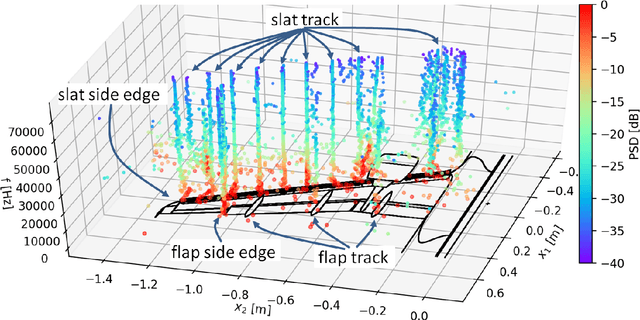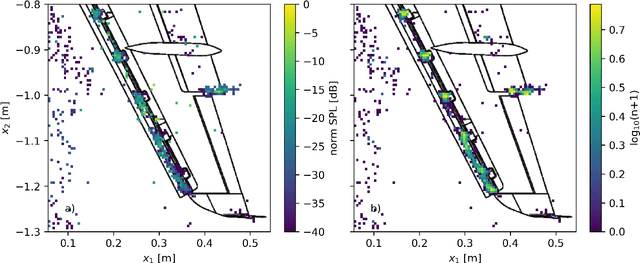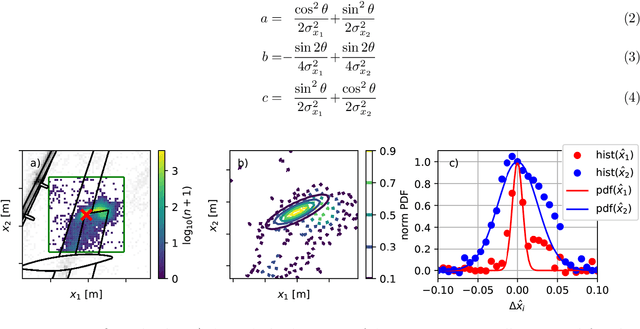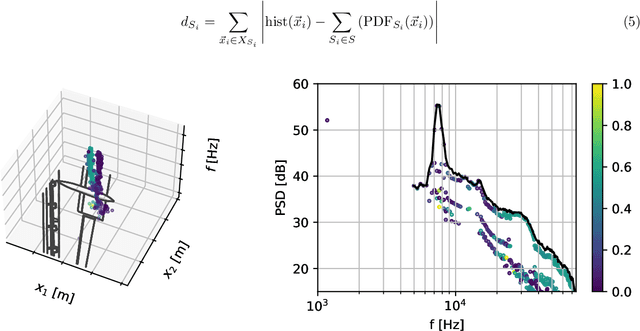Armin Goudarzi
Enhancing Aeroacoustic Wind Tunnel Studies through Massive Channel Upscaling with MEMS Microphones
May 06, 2024Abstract:This paper presents a large 6~m x 3~m aperture 7200 MEMS microphone array. The array is designed so that sub-arrays with optimized point spread functions can be used for beamforming and thus, enable the research of source directivity in wind tunnel facilities. The total array consists of modular 800 microphone panels, each consisting of four unique PCB board designs. This modular architecture allows for the time-synchronized measurement of an arbitrary number of panels and thus, aperture size and total number of sensors. The panels can be installed without a gap so that the array's microphone pattern avoids high sidelobes in the point spread function. The array's capabilities are evaluated on a 1:9.5 airframe half model in an open wind tunnel at DNW-NWB. The total source emission is quantified and the directivity is evaluated with beamforming. Additional far-field microphones are employed to validate the results.
B-CLEAN-SC: CLEAN-SC for broadband sources
Jul 12, 2023Abstract:This paper presents B-CLEAN-SC, a variation of CLEAN-SC for broadband sources. Opposed to CLEAN-SC, which ``deconvolves'' the beamforming map for each frequency individually, B-CLEAN-SC processes frequency intervals. Instead of performing a deconvolution iteration at the location of the maximum level, B-CLEAN-SC performs it at the location of the over-frequency-averaged maximum to improve the location estimation. The method is validated and compared to standard CLEAN-SC on synthetic cases, and real-world experiments, for broad- and narrowband sources. It improves the source reconstruction at low and high frequencies and suppresses noise, while it only increases the need for memory but not computational effort.
Aeroacoustic testing on a full aircraft model at high Reynolds numbers in the European Transonic Windtunnel
Jul 11, 2023Abstract:This paper presents an end-to-end approach for the assessment of pressurized and cryogenic wind tunnel measurements of an EMBRAER scaled full model close to real-world Reynolds numbers. The choice of microphones, measurement parameters, the design of the array, and the selection of flow parameters are discussed. Different wind tunnel conditions are proposed which allow separating the influence of the Reynolds number from the Mach number, as well as the influence of slotted and closed test sections. The paper provides three-dimensional beamforming results with CLEAN-SC deconvolution, the selection of regions of interest, and the corresponding source spectra. The results suggest that slotted test sections have little influence on the beamforming results compared to closed test sections and that the Reynolds number has a profound, non-linear impact on the aeroacoustic emission that lessens with increasing Reynolds number. Further, sources show a non-linear Mach number dependency at constant Reynolds number but are self-similar in the observed Mach number range. The findings suggest that it is possible to study real-world phenomena on small-scale full models at real-world Reynolds numbers, which enable further investigations in the future such as the directivity of sources.
Global, and Local Optimization Beamforming for Acoustic Broadband Sources
Nov 09, 2022Abstract:This paper presents an extension to global optimization beamforming for acoustic broadband sources. Given, that properties such as the source location, spatial shape, multipole rotation, or flow properties can be parameterized over the frequency, a CSM-fitting can be performed for all frequencies at the same time. A numerical analysis shows that the non-linear error function for the standard global optimization problem is similar to a Point Spread Function and contains local minima, but can be improved with the proposed broadband optimization. Not only increases the broadband optimization process the ratio of equations to unknown variables, but it also smooths out the cost function. It also simplifies the process of identifying sources and reconstructing their spectra from the results. The paper shows that the method is superior on synthetic monopoles compared to standard global optimization and CLEAN-SC. For real-world data the results of broadband global optimization, standard global optimization, and CLEAN-SC are similar. However, the proposed method does not require the identification and integration of Regions Of Interest. It is shown, that by using reasonable initial values the global optimization problem reduces to a local optimization problem with similar results. Further, it is shown that the proposed method is able to identify multipoles with different pole amplitudes and unknown pole rotations.
Expert decision support system for aeroacoustic classification
Feb 27, 2021



Abstract:This paper presents an expert decision support system for time-invariant aeroacoustic source classification. The system comprises two steps: first, the calculation of acoustic properties based on spectral and spatial information; and second, the clustering of the sources based on these properties. Example data of two scaled airframe half-model wind tunnel measurements is evaluated based on deconvolved beamforming maps. A variety of aeroacoustic features are proposed that capture the characteristics and properties of the spectra. These features represent aeroacoustic properties that can be interpreted by both the machine and experts. The features are independent of absolute flow parameters such as the observed Mach numbers. This enables the proposed method to analyze data which is measured at different flow configurations. The aeroacoustic sources are clustered based on these features to determine similar or atypical behavior. For the given example data, the method results in source type clusters that correspond to human expert classification of the source types. Combined with a classification confidence and the mean feature values for each cluster, these clusters help aeroacoustic experts in classifying the identified sources and support them in analyzing their typical behavior and identifying spurious sources in-situ during measurement campaigns.
Automatic source localization and spectra generation from deconvolved beamforming maps
Dec 16, 2020



Abstract:We present two methods for the automated detection of aeroacoustic source positions in deconvolved beamforming maps and the extraction of their corresponding spectra. We evaluate these methods on two scaled airframe half-model wind-tunnel measurements. The first relies on the spatial normal distribution of aeroacoustic broadband sources in CLEAN-SC maps. The second uses hierarchical clustering methods. Both methods predict a spatial probability estimation based on which aeroacoustic spectra are generated.
 Add to Chrome
Add to Chrome Add to Firefox
Add to Firefox Add to Edge
Add to Edge